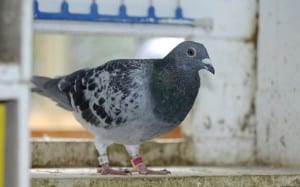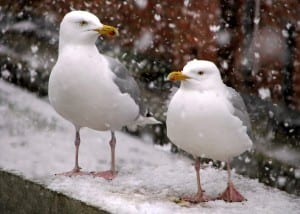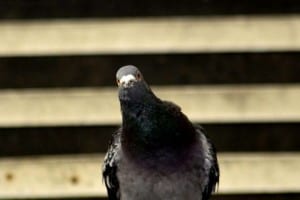
by Pigeon Patrol | Nov 21, 2015 | Animal Deterrent Products, Bird Deterrent Products, Bird Netting, Pigeon Patrol's Services, Pigeon Spikes
 FRANKFURT—The glass-enclosed newsstand on platform 102 at Frankfurt Central Station has bird decals on its doors to ward off errant pigeons. That’s nothing unusual, except the newsstand sits three stories underground.
FRANKFURT—The glass-enclosed newsstand on platform 102 at Frankfurt Central Station has bird decals on its doors to ward off errant pigeons. That’s nothing unusual, except the newsstand sits three stories underground.
“You expect rats or mice, but pigeons?” said traveler Ingeborg Striebl, watching one of the birds peck at crumbs that missed a trash bin. “How do they get down here? Do they come with the train?”
Europe has millions of pigeons. London’s Trafalgar Square is carpeted with them. They swarm San Marco’s square in Venice and the steps of Milan’s cathedral. But those sites are all above ground.
The pigeons of Frankfurt’s Central Station navigate underground corridors like commuters on autopilot. They come and go from the deep suburban-rail platforms by flying inches above escalator riders.
“It is striking to see them down here,” said rider Rosario Scolaro, standing near four pigeons strutting around the newsstand. “One doesn’t expect to see them under these dim ceilings.”
Frankfurt Central is hardly the world’s only city station with pigeons. But representatives for New York’s train stations and the London Underground say the birds aren’t too numerous—and don’t make too many feathers fly.
But in Frankfurt, the station’s open structure and easy access to lower levels have turned it into a subterranean aviary.
The rush-hour nature show isn’t exactly a welcome one. In an attempt to minimize the birds presence in the 19th-century landmark, station operator Deutsche Bahn Service has festooned it with nets, wires and spikes. Nothing has worked. A spokeswoman for the service calls pigeons “the plague.”
And so they keep coming, flying in every direction. It’s in their blood. Their dexterity navigating underground tunnels today “links to their heritage living in cliffs,” says Steve Portugal, a zoologist at Royal Holloway, University of London. Pigeons are the descendants of rock doves—seaside birds that live on precipices and in caves.
That helps to explain why, to pigeons, leafy green trees are for the birds. They prefer to nest on ledges, roofs, beams and other flat surfaces.
“The city perfectly mimics rock doves’ environment,” says Dr. Portugal.
Slow and rotund, pigeons struggle to soar. Their shape is adapted to short bursts of flight, often in tight spaces. Physiognomy and heritage mean pigeons, unlike other birds, have no qualms about dim lighting or spelunking.
“They’re happy to go into dark tunnels,” says Dr. Portugal. “They see a hole in a building and think ‘OK I can do this.’ ” A larger, more graceful bird in a similar spot “couldn’t get the oomph behind it to get back out.”
Humans and other objects pose no obstacle. “Sometimes they fly past at a hair’s breadth,” said Ms. Striebl, the traveler, as a pigeon swooped along the platform toward a tunnel.
Pigeons aren’t just nimble. They’re smart, too. Zoologists say they can count, solve simple puzzles and distinguish between colors and individuals.
“Pigeons could learn to tell a Picasso from a Matisse if you trained them enough,” said Luc-Alain Giraldeau, an expert on pigeons and dean of the Faculty of Science at the University of Quebec. “Some have learned to wait for automatic doors to open,” he said. “Some have learned to operate automatic doors.”
And while people grumble about “flying rats,” few actually want a pigeon-free city, says Peter Havelka, a zoologist at Karlsruhe’s Natural History Museum. Pigeons are part of the collective unconscious, he contends, inextricably bound up with positive associations.
Pigeons were among the first domesticated animals; many instinctively return to their owners. People bred them for food and used their droppings as fertilizer. It’s those droppings, of course, that have soured public opinion—and made some people fearful that the birds will defecate on the fly (they don’t, according to the experts).
“It certainly happens that you have to take cover,” says Annette Drescher, who works at a bakery under the Central Station. To entice pedestrians, the bakery is completely open to the surrounding passageway, which means pigeons also whizz through. “They’re a pest because you never know when something is going to land on you,” Ms. Drescher said.
Dr. Havelka acknowledges humans “have had more profane experiences with pigeons” than as beloved pets. “One falls out of love quickly,” he said. “It’s understandable.”
Frankfurt has managed to keep its greater pigeon population under control with scattered rooftop roosts, known as dovecotes. The oversize birdhouses deter pigeons from nesting in nearby buildings. In an attempt at population control, caretakers also replace some pigeon eggs with convincing fakes—a trick that works until the birds realize their “eggs” aren’t viable. Manager Gudrun Stürmer estimates her team collects about 180 real eggs a month with the switcheroo.
Ms. Stürmer wants to build more dovecotes to help manage the population in “pigeon hot spots” like the station but few Frankfurters are eager to volunteer their rooftops. One bar owner who showed interest later backed out due to sanitation concerns.
“People don’t like them because they’re so much like us,” said Ms. Stürmer. “They’re hungry and there are many of them.” she said.
Still the central station’s pigeons have defenders. “Sometimes they fly right into your face,” said Tesfalem Haile, who works at a juice bar on the main floor. “But they’re a good sign, a symbol of peace.”
About Pigeon Patrol:
Pigeon Patrol Products & Services is the leading manufacturer and distributor of bird deterrent (control) products in Canada. Pigeon Patrol products have solved pest bird problems in industrial, commercial, and residential settings since 2000, by using safe and humane bird deterrents with only bird and animal friendly solutions. At Pigeon Patrol, we manufacture and offer a variety of bird deterrents, ranging from Ultra-flex Bird Spikes with UV protection, Bird Netting, 4-S Gel and the best Ultrasonic and audible sound devices on the market today.
Voted Best Canadian wholesaler for Bird Deterrent products four years in a row.
Contact Info: 1- 877– 4– NO-BIRD (www.pigeonpatrol.ca)

by Pigeon Patrol | Nov 19, 2015 | Animal Deterrent Products, Bird Netting, Pigeon Patrol's Services, Pigeon Spikes
 When I came back to India after a long time and started living in Mumbai, I developed mild wheezing; I dismissed it as my reaction to pollution. Then one day I went up to the terrace of my building and was shocked to see two enormous trays filled with grains mixed with sev (fried stuff made from basan and spices). Birds, especially the friendly neighborhood pigeons and crows feasted on it and the entire floor of the terrace was covered with their droppings. It is at that point I realised that why so many pigeons come to rest near my windows, especially on the base of window grills that project out to give a feeling of space in tiny metropolitan flats.
When I came back to India after a long time and started living in Mumbai, I developed mild wheezing; I dismissed it as my reaction to pollution. Then one day I went up to the terrace of my building and was shocked to see two enormous trays filled with grains mixed with sev (fried stuff made from basan and spices). Birds, especially the friendly neighborhood pigeons and crows feasted on it and the entire floor of the terrace was covered with their droppings. It is at that point I realised that why so many pigeons come to rest near my windows, especially on the base of window grills that project out to give a feeling of space in tiny metropolitan flats.
Naturally, after their fiesta on the terrace, they hover around the building to find some place for their siesta. Some of them even nest and lay eggs, attracting crows who want to eat those.
The fact is that I love birds, and had a cockatiel as a pet for twelve long years, a clean, energetic and dignified fellow (it turned out to be a female at the end) with a tuft on its head. We, the bird and I had become friends, for it thought I am a bird and I thought it has all the human traits. Since I could not bring it to India (ban on exotic birds) and had to put it up for adoption, I missed it terribly and hated to shoo off the pigeons from my window grills. The wheezing continued.
Finally I came to know that my lungs were reacting to the friendly pigeons, but I was lucky that I did not develop a full blown BFD (Bird Fanciers Disease) with symptoms like breathlessness, chills, fever, dry cough and chest discomfort.
The reason behind BFD is that some of us are sensitive to a variety of environmental agents, we repeatedly breathe in making our immune system go for a toss and react violently. In this case, it is the proteins in the bird droppings that float in the air once the droppings dry and become powdery. BFD is not restricted to only pigeons but all the birds and in rare cases keeping a single pet bird can affect the lungs. The symptoms mimic asthma and there is a danger of misdiagnosis. BFD can be diagnosed only with CT scans and X-rays where ‘granulomas’ can be seen (in simple words it can be called localized inflammation). It is usually treated with steroid inhalers.
If not diagnosed or treated properly it can turn complicated with loss of appetite, weight loss and extreme tiredness. It can lead to a very serious condition called ‘fibrosis’ where fibrous tissue (scarring) replaces fine and delicate parts of our lungs (alveoli) where fresh air with oxygen enters our being. More scarring means less fresh air entering our body, and this can be fatal, deadly. Very small children, senior citizens, immune compromised patients are more prone to BFD, and they must wear masks if they live in the midst of pigeons or keep the birds away by not feeding them.
In India we feed birds for two reasons, we love them and also gather religious sentiments with hidden desire to collect ‘good karma’, but are we doing the right thing?
There is one more reason why we must not feed birds on terraces, for their droppings are acidic and over the years can erode the buildings (including the steel), making the structure weak.
The author is a microbiologist and has worked for food and pharmaceutical companies in marketing as well as business development in countries like Germany, India and the United Arab Emirates. She has written articles on ‘health & medicine’ in a leading Marathi newspaper and was also a freelance health columnist for a leading English newspaper in the Gulf for several years. From a young age she was also into writing poetry in Marathi and English, and some of her poems have been published. Now back in India she is a full time writer and pursues farming as a hobby. The first part of her Historical Novel trilogy called ‘Frontiers of Karma – the Counterstroke’ is published (August 2014) by Alchemy Publishers. It is a first novel published on Shivaji Aurangzeb conflict in English where the lives of these mighty men run parallel.
About Pigeon Patrol:
Pigeon Patrol Products & Services is the leading manufacturer and distributor of bird deterrent (control) products in Canada. Pigeon Patrol products have solved pest bird problems in industrial, commercial, and residential settings since 2000, by using safe and humane bird deterrents with only bird and animal friendly solutions. At Pigeon Patrol, we manufacture and offer a variety of bird deterrents, ranging from Ultra-flex Bird Spikes with UV protection, Bird Netting, 4-S Gel and the best Ultrasonic and audible sound devices on the market today.
Voted Best Canadian wholesaler for Bird Deterrent products four years in a row.
Contact Info: 1- 877– 4– NO-BIRD (www.pigeonpatrol.ca)

by Pigeon Patrol | Nov 18, 2015 | 4-S Gel Bird repellent, Animal Deterrent Products, Bird Netting, Pigeons in the News, UltraSonic Bird Control

Seagulls in the Snow by Ron Hill
Two Gulls loving the snow in an Uckfield Garden !!!
Pigeons have been ruffling the feathers of more and more people in recent years.
Last year, the Agri-Food and Veterinary Authority (AVA) received 2,490 complaints about them – mostly about hygiene, environmental issues resulting from their droppings, and concerns over diseases and people feeding them.
There were 2,080 complaints in 2013 and 1,420 in 2012.
The increase has largely been attributed to AVA’s First Responder Protocol implemented in 2012, which includes a 24-hour hotline for reports of animal-related issues.
The Straits Times Forum has also received letters about pigeons pecking on food scraps at coffee shops and hawker centres.
Junior college student Ng J-Cyn said Ghim Moh market is a particular hot spot. Pigeons fly within “inches of diners to peck at crumbs or food waste on the floor”, said the 16-year-old, who is concerned about them spreading diseases. She added: “They also contribute to a very negative dining experience.”
Fellow Forum contributor, Ms Lee Kay Yan, 41, believes the pigeon population will explode unless people stop feeding them.
She said: “Three to five pigeons don’t cause a nuisance but a flock of them do.”
The feeding of pigeons has been banned since 1973 and those caught flouting the rules are fined up to $500. Last year, 60 people were caught doing it, up from just 10 in 2011.
One of the diseases pigeons can spread is psittacosis, a bacterial infection of the lungs with pneumonia-like symptoms.
The bacteria become airborne when the bird droppings dry up and can be inhaled by humans.
Dr Christina Low, medical director of SMG Medical, said thehealth risk to most people is low, although infants, the elderly and individuals who have low immunity “are more vulnerable”.
She advised people to wash their hands thoroughly before meals and reduce pigeon attacks by clearing unfinished food and dirty crockery.
The National Environment Agency (NEA) requires all food shop operators to clean tables promptly and cover rubbish bins. Those who fail to clean tables, for example, can be fined $300 and given four demerit points.
As for Ghim Moh market, the NEA said it has asked the table- cleaning contractor to step up the clearing of tables and crockery.
The agency added that it has so far received only one complaint about pigeons at the market.
Nationwide, it received 35 pigeon-related complaints last year and 36 the year before.
The AVA said it responds to pigeon-related feedback by working with the relevant parties, such as town councils and the NEA.
While poison bait is traditionally used for heavily infested areas that need fast elimination of the birds, a spokesman for pest firm Pest Solute said the use of netting at roof gaps, spikes or a type of sticky gel on window ledges to prevent the birds from nesting is more commonly used.
Food areas are a little trickier and need a combination of these measures, according to Ms Gloria Ngoi, business development manager at bird control firm Mastermark.
These methods, however, are not sustainable if people continue to feed the birds, said Forum writer Ms Lee.
“Preventive measures are better, through good design of buildings to prevent roosting and entry by birds.”
About Pigeon Patrol:
Pigeon Patrol Products & Services is the leading manufacturer and distributor of bird deterrent (control) products in Canada. Pigeon Patrol products have solved pest bird problems in industrial, commercial, and residential settings since 2000, by using safe and humane bird deterrents with only bird and animal friendly solutions. At Pigeon Patrol, we manufacture and offer a variety of bird deterrents, ranging from Ultra-flex Bird Spikes with UV protection, Bird Netting, 4-S Gel and the best Ultrasonic and audible sound devices on the market today.
Voted Best Canadian wholesaler for Bird Deterrent products four years in a row.
Contact Info: 1- 877– 4– NO-BIRD (www.pigeonpatrol.ca)

by Pigeon Patrol | Nov 16, 2015 | Animal Deterrent Products, Bird Deterrent Products, Bird Netting, Pigeons in the News, UltraSonic Bird Control
 Every region of the world seems to have a local critter dish liable to raises visitors’ eyebrows — think boiled lobsters in Maine, dried grasshoppers in Mexico, snails in France and sheep stomach in Scotland.
Every region of the world seems to have a local critter dish liable to raises visitors’ eyebrows — think boiled lobsters in Maine, dried grasshoppers in Mexico, snails in France and sheep stomach in Scotland.
In Amsterdam, two artists are trying to widen their city’s list of local tasty creatures — and expand minds, too — with dishes like the My Little Pony Burger, Peace Pigeon and Bambi Ball.
Their project, The Kitchen Of The Unwanted Animal is a food truck and specialty food provider featuring animals that are, generally, considered pests and almost always considered inedible.
“I think there is a kind of block in your head because it’s a pet or [an animal that’s not typically eaten],” says Rob Hagenouw, 55, one of the founders of the Kitchen. “Here we have pet, pest and eating animals — and we don’t mix them.” But he and his partner, Nicolle Schatborn, 51, are trying to show their neighbors that these animals can be delicious, and shouldn’t be wasted.>
It all started five years ago with a wild goose stew Schatborn and Hagenouw made for an art fair as part of a larger installation. The stew got them wondering about what happened to geese and other animals that were considered “unwanted” in Holland.
“For the past 50 years, it has not been normal to eat the goose in Holland because in the [1970s] the goose was a rare animal,” Hagenouw says.
European laws enacted in the 1970s to protect the rare geese remain in place — the geese cannot be killed unless considered a danger and cannot be sold for profit. In part as a result of these laws, the population of geese has grown to the point of becoming problematic, especially at Amsterdam’s Schipol Airport. Hunters are hired to shoot geese, in a very regulated way, to curb the dangers the birds pose to the engines of flying aircraft and to farmers’ fields. Now, some 400,000 geese are shot in Holland each year and then discarded, often being sent to factories to be ground into pet food.
Schatborn and Hagenouw started talking to some hunters, discovering that the hunted geese were “wasted,” and finally developed the idea to start a food truck. Their first product? Schipol Geese Croquettes.
The croquettes are prepared by boiling the meat, then adding butter to make a thick sauce and, eventually, rolling them in breadcrumbs. It’s an easy entre into the edible goose.
At first, the Schatborn-Hagenouw team made a workshop out of cleaning and preparing the geese, with friends helping out. (They discovered it’s pretty tedious work, so they now bring the geese to a butcher that specializes in birds.)
Rob Hagenouw and Nicolle Schatborn with their geese croquettes, made with boiled goose meat, butter and breadcrumbs.
Rob Hagenouw and Nicolle Schatborn with their geese croquettes, made with boiled goose meat, butter and breadcrumbs.
Courtesy of Rob Hagenouw
And how have the croquettes gone over? “Everyone likes it,” says Hagenouw. But more importantly, he says, it’s a conversation piece. “It was a start – a way to talk about what else is wasted.”
Initially, Hagenouw says, the plan was to wrap up the project after a year. But then they found out about the muskrat.
The semi-aquatic rodent is not indigenous to Holland; one legend has it that a duke brought them in from Hungary for fur in the 1870s. Some escaped and today, 150,000 or more of the invasive critters have made their homes in holes dug into Dutch canals.
Fortunately for The Kitchen For The Unwanted Animal, they’re also tasty.
“Muskrats are plant eaters, so they are really, really delicious when you cook them,” Hagenouw says.
Restrictions on hunters can sometimes make planning for the Kitchen tough. The Kitchen For The Unwanted Animal hosts a five-course “Big Pest Dinner” with a local restaurant twice a year. At a recent dinner, coot, a medium-sized water bird, was on the menu thanks to a hunter who was required by the government to catch enough that it should have supplied the dinner. But, at the last minute, he was told by government regulators that he was not allowed to catch any more.
“We had to find something else,” Hagenouw says. “[Hunting of these animals] is really restricted, it’s very bureaucratic, which is a good thing. We don’t like it when the animals are just shot for fun.”
The “Big Pest Dinner” menu — and that of the food truck — changes based on what’s available at the time. Which brings us to, maybe, the menu item that draws the most attention: the My Little Pony Burger.
The food truck sells about 100 My Little Pony Burgers a day at festivals.i
The food truck sells about 100 My Little Pony Burgers a day at festivals.
Arthur de Smidt /Courtesy of Nicolle Schatborn
Many people in Holland have horses as pets. But as Hagenouw tells it, during the economic crisis in 2011-2012, many families had to give them up because of the high cost of taking care of them. The sale price for a horse dropped by 80 percent.
There were a lot of horses on the market — and many ended up at the butcher. The Kitchen started buying meat from one of a few butchers that specialize in processing horse meat. The food truck now sells about 100 burgers a day at festivals.
“It’s nice meat,” Hagenouw says. “‘Ah, they have My Little Pony burgers,’ little girls will say. Most of the time the girls eat the burgers; it’s the mothers who don’t like it.”
He does say that not all the feedback is positive, especially in the case of the horse burgers. Long ago, horse was eaten in Holland (it’s still a delicacy in some parts of Italy and elsewhere), but only the older set remember, Hagenouw says. But Schatborn and Hagenouw say they try use it as an opportunity to educate people – asking what they eat, suggesting they think about how eating something like chicken differs— from eating goose or horse. They hope that people will recognize that eating horse, for example, is no different than eating cow.
Their “Peace Pigeon” roll – made by baking white breast of pigeon to rare, to prevent it from getting chewy — gets a lot of comments like, “pigeons are disgusting” or “they have diseases” from passersby. But, Hagenouw says, all of their food is prepared by providers under European food safety regulations. So, like with all of their offerings, they try to tell its story. They tell the story of pre-WWII times when pigeons were eaten more frequently. And how in WWII pigeons saved men in war by acting as messengers. And they write poems, like this one:
this is the kitchen of the undesired animal
the continuing polluting beast
the ones we see as an infestation
that bother us in our movements
those birds that ruin our safety
the rats are undermining the dikes
sometimes cultivated
for economic reasons or
fun meat or fur
eventually escaped and
without enemies they live free
and get loads of small ones
and we !!!
we are disturbed !!!!!!
the kitchen of the undesired animal says
no destruction
no needless waste
we shall eat!!!!!!
The Kitchen intends to take their truck on the road, starting this summer, to Belgium and, possibly, France. Next up, they hope to bring the fallow deer and the black crow to people’s plates — both of which are overabundant in Holland. They’ve also been working with crawfish, not native to Holland, and parakeets, considered invasive. And, Schatborn and Hagenouw have started researching unwanted animals in places as far as Korea and Australia.
The Kitchen Of The Unwanted Animal has also begun selling its geese croquettes to restaurants and pubs. And their food truck has been the inspiration for hunters, who’ve begun selling their own croquettes.
Hunters Martijn van de Reep and Tom Zinger say that the Kitchen was an inspiration for starting their Gebroeders de Wolf charcuterie — a butchery focused on goose about six months ago. They make rillettes, patés, smoked breast and dried sausages, selling them to other specialty stores, restaurants and supermarkets.
Maybe, a few years from now, the goose will not be so unwanted.
About Pigeon Patrol:
Pigeon Patrol Products & Services is the leading manufacturer and distributor of bird deterrent (control) products in Canada. Pigeon Patrol products have solved pest bird problems in industrial, commercial, and residential settings since 2000, by using safe and humane bird deterrents with only bird and animal friendly solutions. At Pigeon Patrol, we manufacture and offer a variety of bird deterrents, ranging from Ultra-flex Bird Spikes with UV protection, Bird Netting, 4-S Gel and the best Ultrasonic and audible sound devices on the market today.
Voted Best Canadian wholesaler for Bird Deterrent products four years in a row.
Contact Info: 1- 877– 4– NO-BIRD (www.pigeonpatrol.ca)

by Pigeon Patrol | Nov 14, 2015 | 4-S Gel Bird repellent, Animal Deterrent Products, Bird Netting, Pigeon Patrol's Services, Pigeon Spikes
Dear Otus,
We were driving up to Fayetteville on Scenic 71 last weekend for the St. Patrick’s Festival on the Square when we had to pull over at Winslow. The sky was black with pigeons.
We were stuck at Mikey’s One Stop for a full half hour while they passed. The clerk said this happens every spring and sometimes 10,000 pigeons roost in the trees along the river behind the store.
I know the old proverb, “One swallow does not make a spring,” but how about 100,000 pigeons?
— Ian Zephyr,
Haskell
 Dear Ian,
Dear Ian,
It was wholly a pleasure to hear from you. And congratulations! You and your family witnessed the annual spring migration of the famous pigeons of Mission San Zahurda de la Jorogado.
The pigeons begin arriving at the old mission in Gravette each spring in the days before what the locals jokingly call the “venal equinox.” That’s when the sun crosses the celestial equator on its way north along the ecliptic.
This year, spring arrived in Arkansas at 6:45 p.m. Friday. Today, therefore, is the first full day of spring and all the pigeons should have arrived from their wintering grounds by now.
There are about 2,300 folks in Gravette and by some estimates, there are about a hundred pigeons for every man, woman and child in town.
The historic mission, on Spavinaw Creek on Arkansas 59 just south of the city limits, was founded in 1542 by Father Cabeza de Gato after he split off from the Hernando de Soto expedition to minister to the Wah-Zha-Zhi Indians.
The priest’s simple mud and wattle structure was expanded and modernized over the years to today’s impressive brick and sandstone Greco-Roman style structure (an architectural anomaly for early Northwest Arkansas), which dates from 1842.
The mission is the most northern and eastern of the famous string of Spanish outposts that begins in south Texas with Mission San Antonio de Valero (the Alamo) and stretches beyond the Red River to Arkansas.
San Zahurda’s picturesque complex of 18 buildings is on the National Register of Histrionic Places and is famous for its tart muscadine wine, muscarine sauce and, of course, its pigeons.
Each year on the first day of spring, visitors from as far away as Tulsa, Neosho, and Harrison come to San Zahurda to witness thousands of pigeons end their migration from their winter home at Mango Deck bar on Medano Beach in Cabo San Lucas, Mexico.
The birds have been performing this annual ritual since long before the mission was founded, but their numbers have greatly multiplied since the early 1900s.
Curator of the San Zahurda museum and unofficial “pigeon daddy” is Lamar Ferreira, who has held the post for the past 17 years.
“Most of our returning birds are feral pigeons,” Ferreira says, “but we have a number of fancy pigeons who’ve joined the migration over the years and it’s always a delight to welcome them back.”
“We had more than 20,000 visitors last year,” Ferreira says of the annual PigeonFest going on today at Pop Allum Park. “We hope to top that figure this year if the weather holds out.”
Although the festival is a boon to the Benton County economy, there are those who do not welcome the influx of birds or tourists for the annual gathering.
“I guess it’d be OK if the birds stayed over on the mission,” says Luther Higgins, who lives on Arkansas 72 on the way to Hiwassee. “But those rats with wings spread out all over the county and leave their droppings on every rock and tree for miles around. If you ask me, they’re a dang nuisance.”
Ferreira is amused by the rat reference. He hears it frequently.
“All pigeons are descended from the noble rock dove, mentioned numerous times in the Bible,” he says. “They have been a benefit to mankind for centuries.”
“Yeah, tell that to my cousin, Wilmar,” Higgins responds. “He come down with the histoplasmosis from them birds.”
“That’s poppycock,” Ferreira insists, pronouncing it in the original Dutch as “pappekak.”
“The Association of Pigeon Veterinarians National Avian Disease Task Force affirms that the raising, keeping and exercising of pigeons and doves represents no more of a health hazard than the keeping of other communal or domestic pets.”
“I’m just glad that pigs don’t fly,” Higgins retorts. “If they did, them yahoos over at the mission would have us knee-deep in porker poppycock. I don’t know what it is they feed them birds, but I bet they have ’em hooked on that muscarine sauce.”
Until next time, Kalaka reminds you to take your cameras and that muscarine sauce goes just swell with squab.
About Pigeon Patrol:
Pigeon Patrol Products & Services is the leading manufacturer and distributor of bird deterrent (control) products in Canada. Pigeon Patrol products have solved pest bird problems in industrial, commercial, and residential settings since 2000, by using safe and humane bird deterrents with only bird and animal friendly solutions. At Pigeon Patrol, we manufacture and offer a variety of bird deterrents, ranging from Ultra-flex Bird Spikes with UV protection, Bird Netting, 4-S Gel and the best Ultrasonic and audible sound devices on the market today.
Voted Best Canadian wholesaler for Bird Deterrent products four years in a row.
Contact Info: 1- 877– 4– NO-BIRD (www.pigeonpatrol.ca)

by Pigeon Patrol | Nov 12, 2015 | Animal Deterrent Products, Bird Deterrent Products, Bird Netting, Pigeon Patrol's Services
 DAHO FALLS, Idaho — Police in Idaho Falls have lifted a code red for the downtown area after a gunman was spotted on top of a commercial building on North Eastern avenue.
DAHO FALLS, Idaho — Police in Idaho Falls have lifted a code red for the downtown area after a gunman was spotted on top of a commercial building on North Eastern avenue.
The incident happened at 550 North Eastern Ave. on the corner of Birch Street at Great Western Foods.
Officers blocked streets surrounding the building between First and Broadway and Boulevard and Shoup Avenue.
The IFPD and Bonneville County swat teams responded to the area.
After an hour, the swat team was able to get the gunman off the roof of great western foods.
They then identified him as a 16-year-old boy with a pellet rifle and scope.
Officers spent several minutes trying to get the teenager to put the gun down and leave the roof, but after making eye contact with officers he ducked and hid.
Officers say the boy was on top of the roof at great western foods shooting pigeons.
Joelyn Hansen spokesperson for the police department says the boy will not face charges.
“Officers you know are the ones that you know just depends what is going to be the best avenue as far as address the situation and that’s why it’s left to officer’s discretion,” said Hansen.
No injuries were reported and the name of the boy is not being released
About Pigeon Patrol:
Pigeon Patrol Products & Services is the leading manufacturer and distributor of bird deterrent (control) products in Canada. Pigeon Patrol products have solved pest bird problems in industrial, commercial, and residential settings since 2000, by using safe and humane bird deterrents with only bird and animal friendly solutions. At Pigeon Patrol, we manufacture and offer a variety of bird deterrents, ranging from Ultra-flex Bird Spikes with UV protection, Bird Netting, 4-S Gel and the best Ultrasonic and audible sound devices on the market today.
Voted Best Canadian wholesaler for Bird Deterrent products four years in a row.
Contact Info: 1- 877– 4– NO-BIRD (www.pigeonpatrol.ca)

 FRANKFURT—The glass-enclosed newsstand on platform 102 at Frankfurt Central Station has bird decals on its doors to ward off errant pigeons. That’s nothing unusual, except the newsstand sits three stories underground.
FRANKFURT—The glass-enclosed newsstand on platform 102 at Frankfurt Central Station has bird decals on its doors to ward off errant pigeons. That’s nothing unusual, except the newsstand sits three stories underground.









